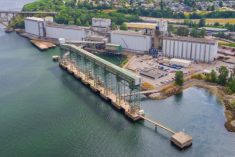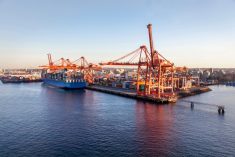Two ports hosting grain terminals are up for sale and possibly divestiture under a new federal program to get out of the port business.
Transport Minister Lisa Raitt on Friday announced a new Ports Asset Transfer Program (PATP) to “facilitate the transfer” of port facilities to other owners or levels of government, naming 50 ports the government aims to get off its books.
Among those are the Port of Owen Sound on Georgian Bay in southwestern Ontario, home to the 93,000-tonne capacity Great Lakes Elevator terminal, operated by Winnipeg grain company Parrish and Heimbecker (P+H).
Read Also

U.S. grains: Corn, soybeans higher in technical bounce; wheat firms
Chicago | Reuters – Chicago corn futures rose modestly on Thursday on chart-based buying, firm cash markets and reminders of…
The PATP list also includes the Port of Baie-Comeau on the St. Lawrence Seaway, home to Cargill’s 441,780-tonne capacity grain terminal.
P+H was in talks with Transport Canada’s port programs directorate up until January last year to take over the Owen Sound port, but Transport Canada announced that month the talks had “ended without a divestiture being concluded.”
Local media have previously reported Owen Sound’s harbour bottom was filling with silt and needed dredging soon to remain viable for commercial boat traffic, but Transport Canada has said it would deal with the dredging issue only once a deal is sealed for divestiture of the harbour.
In a 2012 evaluation of its port operations program, Transport Canada found Baie-Comeau and Owen Sound — plus four other ports remaining on the PATP list — were still “actively utilized as commercial wharves or ports with ongoing relevance to the community and the region.”
“Local opportunities”
The PATP will have “engagement, sale and divestiture” phases. In the first phase, Transport Canada will “communicate with other federal departments, provincial/territorial governments, municipalities, aboriginal groups and other interested parties” providing information about the program.
In the sales phase, due to launch this summer, PATP-listed port facilities will first be offered to other federal departments, the provinces or territories, and municipalities.
If those governments or departments aren’t interested, Transport Canada will shop the ports to “other interested parties” such as aboriginal communities, non-government organizations, the private sector and Canada Port Authorities.
The PATP, Transport Canada said, “includes specific timelines for negotiations and transactions with interested parties, and greater operational flexibility for new port facility operators, including the possibility of developing port sites for desired alternative uses.”
If no takers come forward in the sales phase, the divestiture phase follows, in which facilities could be sold in parts or shut down. Buyers who come forward during the divestiture phase are warned that a deal may include a condition to keep the port operating for a “specified timeframe.”
Transport Canada also said the divestiture phase could include a grant and/or funding contribution from the federal government “to help continue port facility operations and maintenance.”
Interested buyers who skip the sale phase, waiting for the divestiture, “should be aware that Transport Canada cannot guarantee a port facility’s availability after the initial sales period.”
The PATP list includes 24 other Quebec ports, seven others in Ontario, 10 in British Columbia, three in Newfoundland and Labrador, two breakwaters in Nova Scotia and sites at Berens River, Man. and Fort Chipewyan, Alta.
“Our government understands the importance of these port facilities to the transportation needs and economic sustainability of their local communities,” Raitt said in a release.
The PATP, she said, “offers an excellent opportunity for interested parties to acquire a port facility and to develop it to take advantage of local business, community development and tourism opportunities.” — AGCanada.com Network















